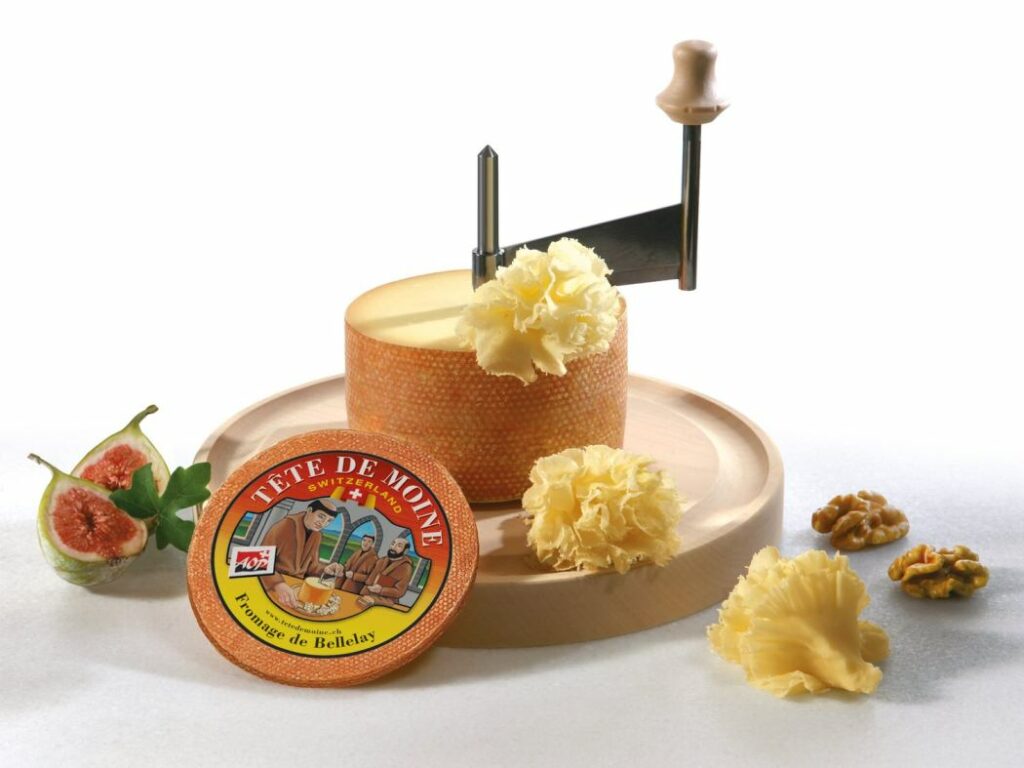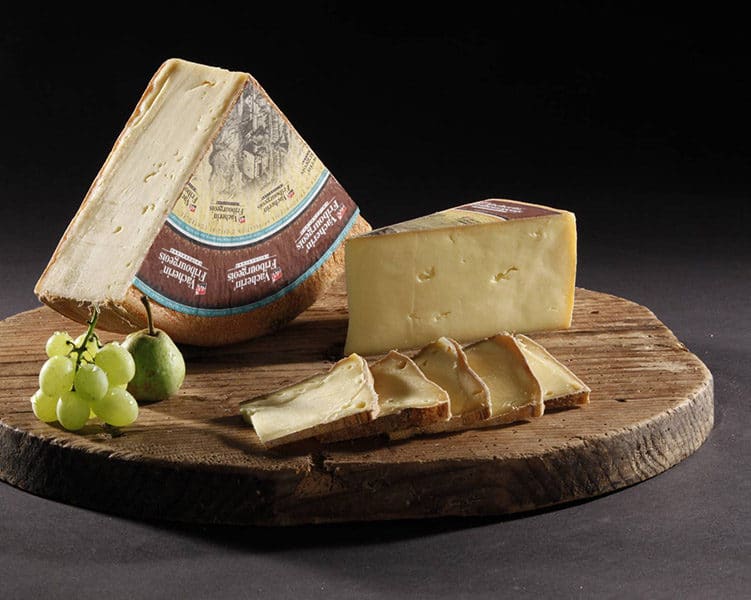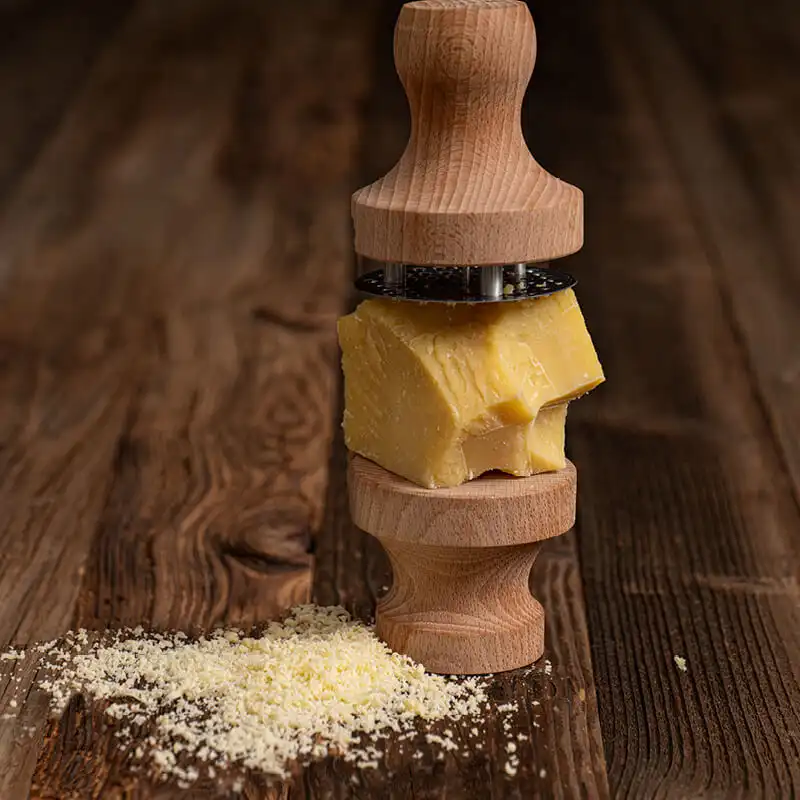What is Swiss Cheese? A Journey from Alpine Pastures to Your Sandwich

Switzerland, a country renowned for its stunning alpine landscapes, is also home to an exquisite culinary tradition that has shaped the gastronomic world. At the heart of this culinary legacy lies one product that stands out for its unique taste and distinct character – Swiss Cheese.
In this guide, we’ll delve into the rich history, various types, and the intricate process of making Swiss cheese.
We will explore the iconic ‘holes’ in Swiss cheese, demystify the myths, and even learn how to best pair these cheeses to elevate your dining experience.
Whether you’re a cheese aficionado, a foodie with a penchant for gourmet delights, or simply someone curious about the world of Swiss cheese, this guide promises to take you on an engaging and informative adventure.
Quick Facts about Swiss Cheese
| Swiss Cheese | Description |
|---|---|
| Origin | Switzerland |
| Milk Source | Cow’s milk |
| Texture | Hard, firm |
| Flavor | The cheese is heated until the bacteria produce gas bubbles, which create the characteristic holes |
| Color | Pale yellow |
| Aging Process | Typically aged for 3 to 4 months |
| Uses | Ideal for sandwiches, fondues, or eaten alone |
| Production Process | The cheese is heated until the bacteria produce gas bubbles, which creates the characteristic holes |
What is Swiss Cheese?
Swiss cheese is a type of cheese that originated in Switzerland. It’s best known for its distinctive appearance, which includes a pale yellow color and large holes or “eyes” throughout the cheese. These holes are formed by carbon dioxide gas bubbles that are produced during the fermentation process.
The flavor of Swiss cheese is typically mild, slightly sweet, and nutty. It’s made from cow’s milk and has a firm, smooth texture. Swiss cheese is often used in dishes like sandwiches and fondues, but it can also be enjoyed on its own.
It’s important to note that “Swiss cheese” is a broad term used primarily in North America. In Switzerland, there are over 450 types of cheese, many of which have their own unique names and characteristics.
Which cheeses are Swiss cheese?
1. Emmental:

Emmental, often known as Swiss cheese, is a classic Swiss dairy product. It’s distinguished by its large holes and creamy, slightly nutty taste. Originating from the Emme valley in the canton of Bern, Emmental is a hard cheese made from cow’s milk. This cheese is perfect for sandwiches or melted in fondue.
2. Gruyère:

Gruyère is a hard Swiss cheese named after the town of Gruyères. It has a sweet yet slightly salty flavor that varies widely with age. The texture of Gruyère is smooth and firm, but it becomes creamier and earthier as it matures. It’s a staple in fondues and gratins, and pairs well with red wine.
3. Appenzeller:

Appenzeller cheese hails from the Appenzell region of Switzerland. This semi-hard cheese has a unique, spicy flavor thanks to a secret herbal brine used during its production. Its texture is firm, and it has small holes throughout. Appenzeller is often enjoyed in casseroles, on bread, or paired with fruit and wine.
4. Raclette:

Raclette is a semi-hard cheese from the Valais region of Switzerland. The cheese is traditionally melted and scraped onto potatoes, pickles, and onions, a dish also named Raclette. The taste is mildly creamy with a distinctive aroma, and it has a smooth, velvety texture.
5. Tête de Moine:

Tête de Moine, or “Monk’s Head,” is a semi-hard cheese from the Jura region in Switzerland. Unlike other cheeses, it’s traditionally shaved into thin rosettes with a Girolle cutter, enhancing its flavors. The taste is complex, with a tangy, fruity edge and notes of fresh hay and nuts.
6. Vacherin Fribourgeois:

Vacherin Fribourgeois is a soft and creamy cheese from the Fribourg canton in Switzerland. It has a slightly acidic, resiny flavor and is often used in fondue because it melts beautifully. The flavor can range from nutty and savory to creamy and earthy, depending on its age.
7. Sbrinz:

Sbrinz is one of the oldest European cheeses, originating from central Switzerland. This hard cheese is often compared to Parmesan due to its grainy texture and rich, slightly spicy flavor. Sbrinz is traditionally cut into thin flakes and used in cooking or eaten on its own with a glass of wine.
What is the most popular Swiss cheese?
Gruyère is arguably the most popular Swiss cheese. It’s constantly imitated, leading consumers to often mistake the generic alpine-style for the real thing.
Gruyère, which has a smooth texture, is the most produced and consumed cheese in Switzerland. This cheese is known for its rich, creamy, and nutty flavor.
>> Click here to read our in-depth guide on Gruyère
What is the difference between Swiss cheese and normal cheese?
Here are some key differences between Swiss cheese and other types of cheese:
| Feature | Description |
|---|---|
| Holes or ‘Eyes’ | The iconic feature of Swiss cheese is the presence of holes or ‘eyes’. These are formed due to the release of carbon dioxide during the fermentation process when the cheese is made. Most other cheeses do not have these holes. |
| Flavor Profile | Swiss cheese typically has a nutty, sweet, and mild flavor profile that’s different from many other types of cheese. The flavor can also vary depending upon the age of the cheese. |
| Texture | Swiss cheeses, like Emmental and Gruyère, tend to have a firm yet pliable texture. This makes them excellent for melting, a quality that sets them apart from many other cheeses. |
| Aging Process | Swiss cheese undergoes a unique aging process that contributes to its distinct flavor and texture. This process can range from a few months to several years. |
| Production Process | Swiss cheese is traditionally made from raw, unpasteurized milk, which gives it a deep and complex flavor. This is not the case with all other types of cheese, many of which are made from pasteurized milk. |
What is special about Swiss cheese?
Swiss cheese, known for its distinctive characteristics, has many aspects that make it special:
1. Holes or ‘Eyes’:
Swiss cheese is famous for its iconic holes or ‘eyes’. These are formed due to the release of carbon dioxide during the fermentation process when bacteria consume lactic acid and produce the gas as a byproduct. The size of the holes can vary depending on the exact type of Swiss cheese and the specific conditions of the fermentation process.
2. Flavor:
Swiss cheese has a unique nutty and slightly sweet flavor. This is a result of the particular strains of bacteria used in its production.
3. Versatility:
Swiss cheese is very versatile. It can be used in a variety of dishes, from sandwiches and fondue to baked goods and gratins. Its excellent melting properties make it a favorite for many recipes.
4. Nutrition:
Swiss cheese is a good source of protein and calcium, and it’s also lower in sodium and fat compared to many other types of cheese. Plus, it contains probiotics, which can be beneficial for gut health.
5. Aging Process:
Swiss cheese undergoes a unique aging process that can range from a few months to several years. The length of this process contributes to the cheese’s texture and flavor.
6. Origin:
Swiss cheese originates from Switzerland, and the traditional method of making it has been passed down through generations. Some Swiss cheeses, like Emmental and Gruyère, are protected by AOP (Appellation d’Origine Protégée) status, meaning they must be produced in a certain way in a specific geographic area.
Swiss-cheese tasting notes
Swiss cheese, specifically the types known as Emmental and Gruyère which are most commonly associated with “Swiss Cheese,” has a unique flavor profile that makes it a favorite among cheese lovers.
Here are some tasting notes:
- Flavor: Swiss cheese typically has a nutty, sweet, and mildly sharp flavor. It’s known for its characteristic richness without being overwhelming. The flavor becomes more complex and robust as the cheese ages.
- Texture: The texture of Swiss cheese is firm yet pliable, and it’s distinguished by its iconic holes or ‘eyes’. These holes are formed due to the release of carbon dioxide during the fermentation process.
- Aroma: Swiss cheese has a light, slightly sweet aroma. The scent can vary depending on the age of the cheese, with older cheeses having a more pronounced smell.
- Aftertaste: The aftertaste of Swiss cheese is usually smooth and lingers gently on the palate, leaving a pleasant, slightly sweet and nutty flavor behind.
- Pairings: Swiss cheese pairs well with fruits like apples and grapes, as well as with crusty breads and cured meats. It also goes well with a variety of wines, including full-bodied reds, dry whites, and even sweet dessert wines.
Also read: What Fruit Goes on a Charcuterie Board?
Is Swiss cheese good to eat?
Swiss cheese is generally considered good to eat and it’s enjoyed by many people around the world. Not only is it tasty, but it also has several nutritional benefits:
- Protein: Like most cheeses, Swiss cheese is a good source of protein, which is essential for building and repairing body tissues.
- Calcium: Swiss cheese is rich in calcium, which is important for bone health.
- Vitamin B12: This cheese contains Vitamin B12, which is essential for brain function and creating red blood cells.
- Low in Fat and Sodium: Compared to many other types of cheese, Swiss cheese is lower in fat and sodium, making it a healthier choice for those watching their intake of these nutrients.
However, as with all foods, it’s important to consume Swiss cheese in moderation as part of a balanced diet. It’s also worth noting that Swiss cheese is made from cow’s milk, so it’s not suitable for those with a dairy allergy or lactose intolerance.
Also read: Savor the Flavor: 20 Cheeses with the Least Lactose
Which is healthier Swiss or cheddar?
Both Swiss and Cheddar cheese have their own health benefits, but there are some differences:
| Health Aspect | Swiss Cheese | Cheddar Cheese |
|---|---|---|
| Sodium and Fat Content | Lower in sodium and fat, making it a healthier choice for those looking to limit their intake. | Typically higher in sodium and fat. |
| Protein | Slightly more protein than Cheddar, contributing to feelings of fullness and stronger bones. | Good source of protein, but slightly less than Swiss. |
| Vitamins & Minerals | Higher in Vitamin B12, Calcium, Phosphorus, and Zinc. Also contains compounds that may help lower blood pressure. | Richer in Vitamin B2 and Monounsaturated Fat. |
| Calories | Typically lower in calories. | Typically higher in calories. |
While both Swiss and Cheddar cheese can be part of a healthy diet, Swiss cheese might be the healthier choice if you’re looking to reduce your intake of sodium, fat, and calories while getting a bit more protein.
>> Click here to read our in-depth guide on Cheddar
Is it OK to eat Swiss cheese every day?
Swiss cheese is rich in protein, calcium, and certain beneficial bacterial species. It’s also lower in fat and sodium compared to many other cheeses, which can contribute to a healthier diet.
However, due to its content of saturated fats and sodium, overconsumption could potentially lead to health issues such as high blood pressure and cardiovascular problems.
Therefore, while it’s not harmful to include Swiss cheese in your daily diet, it’s important to consider portion sizes and balance it with other nutritious foods to maintain a healthy and balanced diet.
Swiss cheese nutrition facts
| Nutritional Aspect | Swiss Cheese |
|---|---|
| Calories | 103-112 |
| Protein | 7.54g-7.7g |
| Total Fat | 8g-8.8g |
| Saturated Fat | 5g |
| Cholesterol | 25mg |
| Sodium | 52mg |
| Carbohydrates | 0.4g-1g |
| Fiber | 0g |
| Sugar | 0g |
Why is Swiss cheese so expensive?
Swiss cheese tends to be more expensive than other types of cheese for several reasons:
- Production Process: The process of making Swiss cheese is more complex and time-consuming compared to other cheeses. This includes the need for specific bacterial cultures and a lengthy aging process, which adds to the cost.
- Quality of Ingredients: Swiss cheese is often made from high-quality ingredients. For example, Swiss cows are often fed a diet that includes chocolate, which can add to the cost of the milk used in the cheese.
- Tariffs and Trade: Depending on where you live, tariffs and trade restrictions can also increase the cost of Swiss cheese. For instance, imported Swiss cheese can be subject to tariffs that drive up its price.
- Supply and Demand: Like any product, the price of cheese is influenced by the laws of supply and demand. Certain varieties of Swiss cheese, like Gruyère, are highly valued and tend to be more expensive.
- Currency Fluctuations: Swiss cheese prices can also be affected by fluctuations in the value of the Swiss franc. If the franc strengthens against other currencies, this can make Swiss products more expensive in those countries.
What cheese is closest to Swiss cheese? The top 5 substitutes
Here are the top five substitutes for Swiss cheese:
- Cheddar Cheese: Cheddar is a good substitute for Swiss cheese due to its fine texture and strong flavor. It’s also quite nutritious.
- Fontina Cheese: This Italian cheese works well as a substitute for Swiss cheese. Its texture varies from semi-soft to hard depending on its age.
- Edam Cheese: Edam is another good substitute with a mild flavor.
- Mozzarella Cheese: Mozzarella can also be used as a substitute, especially in recipes that require a cheese that melts well.
- Sharp White Cheddar: This type of cheddar cheese has a flavor profile that makes it a great substitute for Swiss cheese in various dishes like quiche, casseroles, and pasta.
The best substitute will depend on the specific flavor and texture you’re looking for in your recipe.
What goes well with Swiss cheese?
Food that goes well with Swiss cheese
| Category | Food |
|---|---|
| Meat | Ham, Bacon, Turkey |
| Dairy | Milk, Cottage Cheese |
| Bread | French Bread (Baguette), Pumpernickel Bread |
| Fruits & Veggies | Pickled Fruits and Veggies, White Mushrooms, Asparagus, Grapes, Pears |
| Other | Confit-Style Jams |
Beverage that goes well with Swiss cheese
| Category | Beverage |
|---|---|
| Wine | White Zinfandel, Gamay Beaujolais, Dry Red Wine, Cabernet Sauvignon, Merlot, Sauvignon Blanc, Port, Sherry, Riesling |
| Liquor | Dark Rum, Bourbon, Rye Whiskey |
| Non-Alcoholic | White Tea, Coffee, Drinking Chocolate, Lemonade, Soda |
| Beer | Lager, Pilsner, Bock, Weiss Beer |
The history of Swiss cheese
Swiss cheese, known for its distinctive holes or “eyes”, originates from Switzerland, specifically the Emmental region. Its history dates back to the early 19th century.
The cheese was initially produced by Swiss farmers and monks in the Emmental region. It was made in large wheels because it aged well, and it could be stored for long periods without refrigeration, which was a significant advantage in the times before modern refrigeration.
The method of making Swiss cheese involves heating cow’s milk, adding a starter culture and rennet to form curds, and then pressing the curds into molds. The cheese is then aged for several months. The iconic holes in Swiss cheese are caused by the release of carbon dioxide gas during the fermentation process.
Swiss cheese became popular worldwide due to its unique flavor and texture. It was introduced to America by Swiss immigrants, where it became particularly popular and began to be produced on a large scale.
Today, Swiss cheese is enjoyed worldwide and is widely used in cooking for its melting properties. It’s used in various dishes like sandwiches, fondue, quiches, and more.
Frequently Asked Questions
1. Is mozzarella a Swiss cheese?
No, Mozzarella is not a Swiss cheese. It’s an Italian cheese made from the milk of water buffalos or cows.
It’s best known for its use in Italian dishes like pizza and lasagna due to its excellent melting properties.
Unlike Swiss cheese, Mozzarella does not have holes and has a mild flavor.
The traditional Mozzarella cheese, Mozzarella di Bufala, is made from the milk of domestic water buffalo in Italy and is a product with a protected designation of origin.
>> Click here to read our in-depth guide on Mozzarella
2. Does Swiss cheese melt easily?
Yes, Swiss cheese does melt easily.
It’s known for its excellent melting properties, which makes it a popular choice for a variety of dishes. Its smooth, flowing melt is ideal for sandwiches, fondues, and baked dishes. The fact that it melts so well is due to its moderate moisture content and its semi-hard texture.
However, the meltability can vary depending on the specific type of Swiss cheese and its age. For instance, younger Swiss cheese tends to melt more smoothly than aged Swiss cheese.
3. Is Swiss cheese high in cholesterol?
Swiss cheese is not particularly high in cholesterol compared to some other types of cheese. One slice of Swiss cheese has about 26 milligrams of cholesterol. In comparison, Cheddar cheese has a higher percentage of saturated fat, which is a significant contributor to cholesterol.
However, like all dairy products and many animal foods, cheese does contain cholesterol and saturated fat. Some research suggests that a diet high in saturated fats may lead to an increase in LDL (bad) cholesterol, which raises the risk of plaque. Therefore, while Swiss cheese is considered lower in cholesterol than some other cheeses, it should still be eaten in moderation as part of a balanced diet.
It’s also worth noting that Swiss cheese is lower in sodium than many other cheeses, which can be beneficial for those monitoring their sodium intake.
4. How to properly store Swiss cheese?
Storing Swiss cheese properly can extend its freshness and prevent it from drying out or becoming moldy.
Here are some steps you can follow:
- Wrap It Well: After you’ve opened your Swiss cheese, wrap it tightly in wax paper or parchment paper. This allows the cheese to breathe while also preventing it from drying out.
- Plastic Wrap or Foil: After wrapping in paper, you can add a layer of plastic wrap or aluminum foil for extra protection.
- Use a Cheese Bag or Cheese Paper: If available, cheese bags or cheese paper are designed specifically for storing cheese and can be a great option. They allow moisture to escape while keeping the cheese protected.
- Refrigerate: Store your wrapped cheese in the refrigerator. The vegetable drawer is often a good spot because it’s slightly warmer than the rest of the fridge, which is ideal for most cheeses.
- Don’t Freeze Swiss Cheese: Freezing can alter the texture of Swiss cheese, making it more crumbly and less enjoyable. It’s best to store Swiss cheese in the fridge and consume it within a few weeks.
- Check Regularly: Keep an eye on your cheese. If you notice any mold, remove that piece of cheese immediately to prevent it from spreading to the rest of the cheese.
Remember, it’s always best to buy cheese in amounts that you’ll consume within a few weeks to ensure you’re eating it at its best quality.
5. Which Swiss cheese is suitable for a pregnant woman?
Swiss cheese is generally safe for pregnant women to eat, as long as it’s made from pasteurized milk.
The pasteurization process involves heating the milk to a temperature of 161 °F (72 °C) for 15 seconds, which kills any harmful bacteria that could potentially pose a risk during pregnancy.
Aged Swiss cheese, which is typically harder, is also considered safe during pregnancy. This is because the aging process and low moisture content make it less conducive to bacterial growth.
However, it’s always important for pregnant women to check the labels on any cheese they plan to consume to ensure it’s made from pasteurized milk. If you’re unsure or can’t find the information on the label, it’s best to avoid it.
6. What are the holes in Swiss cheese called?
The holes in Swiss cheese are called “eyes.” These eyes are formed during the fermentation process when bacteria release carbon dioxide gas. The gas gets trapped, creating these characteristic bubbles or holes.
If the cheese doesn’t have any holes, it’s referred to as “blind.”
Also read:
- Discovering Panela: A Guide to Mexico’s Versatile Cheese
- Pecorino Romano: The Ultimate Guide to Italy’s Age-Old Cheese
- Utz Cheese Balls: The Ultimate Guide (Taste the Tradition)
- A Guide to Havarti: The Star Cheese of the Culinary World
- The Ultimate Guide to Hoop Cheese: A Southern Delight
- Cheese Curds: The Unsung Heroes of the Dairy World
- Fior di Latte: A Comprehensive Guide to Italy’s Creamy Delight





